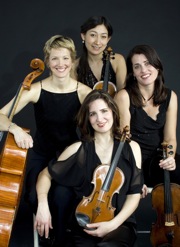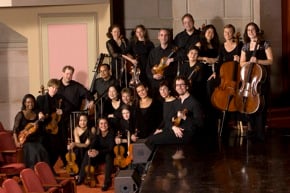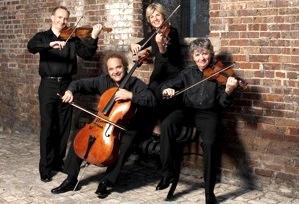Chamber music is everything from traditional string quartets to So Percussion to small orchestras. You would need an entire iPhone app linked to the Classical Voice calendar to keep track of all the chamber music events in the Bay Area. Instead of an app, we have an op: Michelle Dulak Thomson, SFCV’s longtime string quartet maven, who gives you the inside scoop on five hot small ensembles playing here this fall.
 Takács, Takács Everywhere
Takács, Takács Everywhere
Admirers of the Colorado-based Takács Quartet (and of its newest member, longtime San Francisco Symphony principal violist Geraldine Walther) have Berkeley’s Cal Performances to thank for the ensemble’s twice-yearly visits the last several seasons running. This year, though, the quartet is spreading the wealth around to the other three inner–Bay Area counties, as well. Besides the fall Cal Performances recital on Dec. 5, the quartet visits San Francisco’s Herbst Theatre (Oct. 9), Mt. Tamalpais United Methodist Church in Mill Valley (Oct. 10), and Stanford’s Dinkelspiel Auditorium (Dec. 3).
To make matters yet more complicated for the peripatetic Takács-follower, the four programs overlap hardly at all. Mendelssohn’s youthful and impassioned A-minor Quartet appears twice, but otherwise we’re faced with four completely different quartet feasts, offering among them (besides the Mendelssohn) three quartets by Haydn, two by Bartók, two by Beethoven, two by Schubert, one by Shostakovich (the underplayed No. 2), and a new work by Daniel Kellogg.
Forced to choose one, I, well, wouldn’t. Except that I really am forced to choose, so I’ll plump for San Francisco Performances’ on Oct. 9 — partly for the heady program (Haydn, Bartók, and Beethoven), and partly because if you’re smitten by this performance, there are still three left before the year’s out.
San Francisco Performances presents the Takács Quartet, Oct. 9, 8 p.m., Herbst Theatre, S.F., $35-$60.
Brace Yourself for a Joyful Noise: The Czech Nonet
Want to have fun reading through chamber music? Well, play the best music you can get your fingers around. Want to include bystanders in the fun, though? Find yourself a pile of early-Romantic chamber music for a bunch of strings and a clutch of winds, start at the top, and keep playing: It’s not all equally good, but I don’t know any other body of music that’s so satisfying both to play and to hear.
It seems that a group of Prague students in 1924 tried this with Ludwig Spohr’s Nonet Op. 31, and they’ve kept playing ever since. No, not literally; to judge by the ensemble’s Web site, most of the players are well under 40. Yet the ensemble’s history is unbroken, which is to say that when it puts Isa Krejcí’s 1937 Nonet-Divertimento and Bohuslav Martinů’s 1959 Nonet on its October recital, it’s playing two works it commissioned itself. Joining those two on the program is a third commission (from Daniel Asia) completed just this year. I am trying to think of another ensemble with a commissioning history as long as that, and I’m stumped.
Morrison Artists Series presents Czech Nonet, Oct. 10, 3 p.m., McKenna Theatre, San Francisco State University, free.
The Lark Quartet Gathers a Bouquet

String quartets tend to rely for their meat and drink on big, imposing pieces. Yet there’s much else out there, and every so often an ensemble has the wit to gather up the little things and make a program of them.
The Lark Quartet’s tidbits on its Kohl Mansion program are of two kinds. The Dvořák Cypresses (there are 12, though the ensemble’s not playing all of them) are mostly arrangements of much earlier songs. Mendelssohn’s Four Pieces, Op. 81, are from all over the place — the first two may be part of an unfinished quartet, the third is from some years prior, and the last from a couple of decades earlier than that. They don’t add up to an extra Mendelssohn quartet, but they are all first-class Mendelssohn.
The rest of the concert features, if you’ll pardon me, the Lark ascending. The three new works here weren’t all written for this group, but the ensemble has featured early in the history of all of them. Jennifer Higdon’s pointedly named An Exaltation of Larks is for just the quartet; Theodore Wiprud’s American Journal and Elena Ruehr’s Song of the Silkie, both for baritone and quartet, feature baritone Stephen Salters.
Music at Kohl Mansion presents the The Lark Quartet, Oct. 24, 7 p.m., Kohl Mansion, Burlingame, $15-$45.
Kremerata Baltica
Latvian violinist Gidon Kremer’s ferocious chamber orchestra of young players from the Baltic states, Kremerata Baltica, has played in the Bay Area before. Now, as then, the ensemble builds its program around a monumental, early-Romantic string quartet transcribed for string orchestra. Few quartets take to being blown up this way, but Beethoven’s Op. 131 — a seven-movements-without-a-break odyssey — is one that can be. Leonard Bernstein made it work. Expect something sharper-edged and quirkier from Kremer’s band, though.
The other half of the program, by contrast, is all little pieces — but nearly all 21st-century, and hailing from all over the globe. It’s no great shock to find Arvo Pärt here (a birthday tribute to Kremer, from a fellow Baltic), but Michael Nyman (for example) is something of a surprise.
Cal Performances presents Kremerata Baltica, Oct. 31, 3 p.m., Zellerbach Hall, Berkeley, $42-$72.
All Fiddles: New Century Chamber Orchestra and Mark O’Connor

Does bringing in fiddle virtuoso Mark O’Connor as the New Century Chamber Orchestra’s third composer in residence suggest that Music Director Nadja Salerno-Sonnenberg is lunging for the low-hanging fruit? I don’t think so. O’Connor is more of a small-piece kind of guy; still, he can write — not quite so well as he can play, but nonetheless with verve enough for three.
On the NCCO’s November set, O’Connor is playing old stuff, or rather what passes for “old stuff” where the composer is the player. The big item is Strings and Threads, which O’Connor bills as a sort of history of American vernacular fiddling, in 13 tiny movements.
The other half of the concert is Dmitri Sitkovetsky’s by-now-ubiquitous string orchestra arrangement of Bach’s Goldberg Variations. Every generation discovers that you can transcribe Bach for anything and it’ll work, but even then there are degrees. Sitkovetsky’s Goldbergs work much, much better than most Bach arrangements, and the combined goosing of Salerno-Sonnenberg and O’Connor (two quite different but very vivid "fiddlers") ought to make this uncommon fun.
Mark O’Connor and the New Century Chamber Orchestra, “Waltzing in Appalachia,” Nov. 18, 8 p.m., First Congregational Church, Berkeley; Nov. 19, 8 p.m., First United Methodist Church, Palo Alto; Nov. 20, 8 p.m., Herbst Theatre, S.F.; Nov. 21, 5 p.m., Osher Marin JCC, San Rafael, $29-$49.

